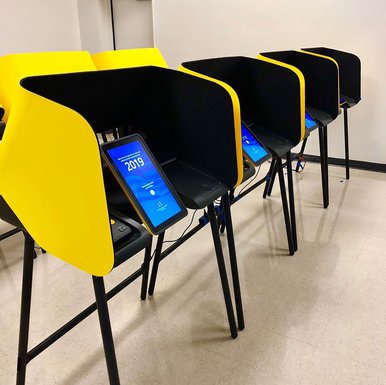Founding president Jared Marcotte shares his perspective on the election changes in Los Angeles County on Super Tuesday.
Election officials share similar goals of making elections as accessible, efficient, and secure as possible. This involves making sure voters understand what they’re doing and ensuring that our votes will be counted accurately.
But even with these shared goals, every jurisdiction has its own way of running elections—each with its own unique set of advantages and challenges. Some states are entirely vote-by-mail. Some states permit counties to opt in to conducting all elections by mail. Other states offer extensive early voting; some offer none. Some have a blend of multiple election models. It’s complicated, to say the least.
For its March 3, 2020 presidential primary, Los Angeles County began using new, county developed-and-designed Ballot Marking Devices (BMDs), which perfectly adhere to the NIST election glossary definition. The concept is to combine the usability and accessibility benefits of a touchscreen-based system with the security of a paper ballot.
Having spent the last seven years as a member of the Technical Advisory Committee for the Voting System for All People (VSAP), the project tasked with developing these new voting machines, I wanted to be on the ground when they were rolled out. Now, having witnessed the wave of negative stories about Los Angeles County’s handling of their most recent primary election, I want to share my own experience and perspective, and speak not just from my observations as a member of VSAP, but also from my first-hand account in the field.
So, here’s what I observed and what I believe from visiting one of a few relatively small vote centers in Los Angeles County—not the thick of things in downtown Los Angeles. This is but one story among many about the experience in Los Angeles County.
The ballot
Before I headed to the vote center, I wanted to see a sample ballot to get an idea of the length, so I looked one up for an address near the vote center. It wasn’t a short ballot. There were about 23 contests and ballot measures on the Democratic Party ballot, with about 23 million (give or take a few million) candidates for each. Longer ballots add complications to the voting process—unavoidable ones, to be sure—but, while designing the BMDs, we considered some tools to alleviate these issues.
Part of the VSAP solution is an Interactive Sample Ballot (ISB) that allows voters to fill out a sample ballot on their phones. Once completed, the ISB generates a barcode that the BMD can scan and populate with the voter’s choices—essentially, a pre-filled ballot. If poll workers can go through voter lines and ask if people with smartphones want to fill out their ballots by browsing to the ISB site while they are in line, it could help save a significant amount of time at the machines.
The polling location
When I arrived at the first vote center, I saw a line that started at the front door and snaked around a hallway until it came back to the voting room. I stood in the line for a few minutes, observing one of the poll workers walk through the line to ask if anyone had an absentee ballot to drop off. Anyone who answered “yes” was ushered inside the voting area to quickly drop off their ballot and leave. Everyone else continued to wait in line—approximately 10-20 minutes, at the vote centers I observed—to get access to a voting machine while voters who dropped their ballots off waited about 2-5 minutes. There were lines, but they seemed to lack frustrated voters. There was a wait, but people seemed to bear it. It was a far cry from the chaos I read about later in the day.
Seeing the same poll worker walk by, again, I asked if I could observe. He guided me inside the small room filled with about 10-15 BMDs. I stood in a corner, away from the voters, and observed the process for a few hours.
Ballot marking devices in action

Every BMD in the room was being used, and quickly refilled as voters finished marking their ballots. The ballots took a bit of time to fill out due to the length, so the turnover was fairly slow. None of the machines were out of order and every one of them was utilized.
However, a common issue I did notice was voter confusion about where to put ballots after they were printed from the BMD. At the end of the voting selection process, the BMD kicks out the printed ballot to present to the voter. Here’s the security context—this process allows the voter to verify that the machine printed their selections on the ballot as intended. If the machine had been compromised or malfunctioning, this would be the only way to catch the issue before the ballot is cast.
But most voters aren’t aware of these security concerns. I noticed a number of voters take the printed ballot and look aimlessly around the room, presumably looking for a separate ballot box. Having a few hours of voting under their belts, the poll workers noticed fairly quickly if a voter looked confused or concerned, and would walk over to ask if there were any issues—and then, they’d explain that every machine has a ballot box and that the voter simply needs to put the ballot back into the BMD.
Even with speedy recognition and turnaround, every confused voter still takes about 1-2 minutes to be recognized and instructed on what to do next. Due to the sheer size of Los Angeles County’s registered voter population and how infrequently many of them vote—i.e. many voters only vote every 2 or 4 years—even a few additional seconds will affect the rate in which voters can progress through voting process within a given voter center.
How can we potentially speed things up more? It’s a hard problem to solve and, like the option to use the ISB, a lot of it has to do with voter education. One potential solution can be to have poll workers dedicate a few more seconds to explaining to each voter, before they vote, how the BMD works, specifically that the system will print out the ballot, and that it will need to be re-inserted back into the machine. However, adding additional time on check-in process will also affect throughput. Security and throughput challenges associated with BMDs will require more thought, from a range of perspectives, to solve. Researchers like Matt Bernhard (a Computer Science PhD candidate at the University of Michigan and lead author of a study on whether voters can detect manipulation of Ballot Marking Devices) and Michael Byrne (a VSAP TAC member, professor of Human Computer Interaction at Rice University, and co-author of a study on voter verification of BMD ballots) are working to tackle these problems. I’m hopeful that their efforts will bear fruit.
Planning for the unknown
It’s hard to plan for the new and unknown. Everything was new in Los Angeles County that Tuesday and the days of early voting leading up to it—the voting model, the pollbooks, and the voting machines. There were many changes and there was no data to ascertain how each of the changes would potentially play out or how they might potentially intersect and exacerbate any issues that surface.
Dean Logan, Los Angeles County Registrar-Recorder/County Clerk, held a press conference where he addressed some of the check-in problems, resource allocation—placement of voting centers, number of machines/poll workers—and the assumption that Election Day volume would be reduced by the new early voting period. One article noted that only a fraction of the committed poll workers showed up to some polling locations.
Executing an election well is difficult in the best of times, and infinitely more so for the most populous county in the country—Los Angeles—with new processes and equipment in a presidential election year. But I am glad that there are election officials all over the country that sacrifice so much of their time to ensure our elections are run—and I’m equally glad that people like Dean exist that are willing to take risks to push the envelope of elections to make it better for everyone. I count Dean as a friend, and he is one of the best election officials in the country running one of the most complex jurisdictions in the country. I doubt anyone else could have achieved better results under these circumstances and I know he and his team are committed to improving the system for all Los Angeles County voters.
I also believe there are lessons we can all learn from this election. The challenges we saw in Los Angeles County all point to the importance for changes to be data driven. To learn what works, we need to know what is being changed—and we need to log, closely, what effects those changes have. For example, with BMDs being pulled out of service, are there common problems? Are those problems mechanical or caused by bugs in the software? With ePollbooks in busy polling locations, could the check-in be analyzed to give a quantitative view of throughput at a given polling location—or even all polling locations if the pollbooks are synced? Could the number of check-ins and ballot drop-offs at the individual vote centers help forecast vote center utilization for future, similar—e.g. primary, general, special—elections?
Los Angeles County is likely already doing many of these activities to prepare for upcoming elections. Some of this analysis may be performed in real time—depending on whether the system and resources are in place to do so—but some information would need to be analyzed after the election.
No election model is perfect
No election model is perfect and there are no silver bullets. There are some who believe that hand-marked paper ballots should be the only method of voting. However, there are clear accessibility issues that need to be overcome. Some may also advocate for all-mail voting, pointing to states like Colorado and Washington that enjoy higher rates of participation. There are highly migratory populations that have participation problems if mailed ballots are the only option. There’s another concern around mail ballots: with so many jurisdictions looking to quickly switch to this model, no one knows what kind of strain this will put on the postal system. Others may point to some sort of online solution for voting, but there are a number of issues with any internet-connected method of voting—we wrote a paper about the issues and some mitigation strategies, but concluded that there are still no guarantees of security and privacy. To add to the long list of complexities around planning an election, election officials all over have to plan for the biggest election event in the United States during a global pandemic where large gatherings have been deemed a danger to public health. In-person voting will have to include more health-related processes—e.g. the regular sterilization of machines and surfaces after use—for the protection of the voters and poll workers. The hard just became harder.
Standing at the back of the room at that vote center offered me a great view of a large backdrop that had both the VSAP logo and the Los Angeles County seal checkered all over it. Some voters stopped in front of it before they left to take a selfie—or poll worker-assisted picture—with the banner as the background, proudly displaying their “I voted” stickers. Voters are proud of our democracy and seeing that firsthand continues to be one of my favorite parts of this work.
Thank you to the wonderful people who agreed to look at this post and provide feedback, including John Dziurlaj, Josh Franklin, Katy Owens Hubler, and Anastasia Golovashkina.

 Jared Marcotte
Jared Marcotte

